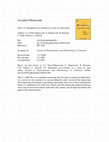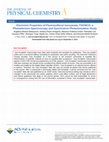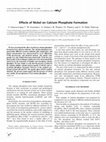Papers by Carlos Omar Della Vedova
Journal of Materials Science Letters, 1994

Journal of Photochemistry and Photobiology A-chemistry, Apr 1, 2009
UV absorption cross-sections of six vinyl ethers (ethyl vinyl ether, 1,4-butanediol divinyl ether... more UV absorption cross-sections of six vinyl ethers (ethyl vinyl ether, 1,4-butanediol divinyl ether, isobutyl vinyl ether, cyclohexyl vinyl ether, 4-hydroxybutylvinyl ether and diethyleneglycol divinyl ether) have been determined in the gas phase between 190 and 230 nm at 303 ± 2 K and pressures up to the corresponding saturation vapor pressures. The main band maxima of the vinyl ethers are below 200 nm with values under 8 x 10-17 cm 2 molecule-1. The absorption vanishes above 225 nm with values of smaller than 1 x 10-21 cm 2 molecule-1. Weak, overlaying vibrational progressions with spacings of 1400 cm-1 are observed for the alkyl vinyl ethers and are less pronounced for vinyl ethers with an extra O atom. Shifts of the positions and intensities are discussed on the basis of the differences in the chemical structure of this series.
Encuentro de Becaries de Posgrado de la UNLP (EBEC) (Modalidad virtual, 12 de noviembre de 2020), 2020
The Journal of Physical Chemistry, 1991
ABSTRACT

Journal of Physical Chemistry A, 2010
A series of closed H-bonded molecules that have (or not) delocalized bonds were studied. The depe... more A series of closed H-bonded molecules that have (or not) delocalized bonds were studied. The dependence of both NMR spectroscopic parameters sigma and J-couplings, and also the energy stability of such molecules with H-bond strength, were analyzed. The selected basic geometrical structure was that of malonaldehyde. From its full optimized geometry, the corresponding geometry of 3-OH propanal was obtained, fixing either the d(O-O) distance or a more extended local geometry and then optimizing the other part of the whole structure. Nitromalonaldehyde and nitromalonamide were also studied because they should have stronger H-bonds and their basic structure is also malonaldehyde. The last one also has electronic effects that may be varied by rotating the amino groups. By doing this it is possible to show that the effects on acidity of donors are more important than the equivalent effects on the basicity of acceptors. It is also shown that J-couplings that involve atoms close to the H-bond have important noncontact contributions that must be included in order to reproduce total J values. Noncontact contributions are more important than the Fermi contact (FC) one for J(O-O) in malonaldehyde. In nitromalonamide all three terms, FC, paramagnetic spin-orbital, and spin-dipolar are of the same order of magnitude when both amino groups are rotated. This does not happen for its planar configuration. Nuclear magnetic shielding of the hydrogen belonging to the H-bond is quite sensitive to it. The magnetic behavior of such hydrogen atom is modified when it is part of a closed H-bonded molecule. Then a relationship between the H-bond strength with the paramagnetic contributions of the shieldings of both atoms, C and O of the donor substructure, was obtained. We have found a cubic correlation between sigma(p) (C) of the C-O donor bond with sigma (H) of the H-bonded hydrogen. It is observed that both the noncontact J-coupling contributions and shieldings on atoms belonging to the donor substructure, give a clear evidence about the presence of the resonance phenomenon in the model compounds that have been studied, malonaldehyde, nitromalonaldehyde, and nitromalonamide.

Spectroscopy of Biological Molecules: New Directions, 1999
Phytochrome is a sensory pigment involved in photomorphogenic processes of plants. The physiologi... more Phytochrome is a sensory pigment involved in photomorphogenic processes of plants. The physiological function is associated with the light-induced interconversion of two stable states, that is initiated by a photoreaction of the tetrapyrrole phytochromobilin (PφB; Fig. 1). To understand the functioning of phytochrome on a molecular level, it is necessary to determine the chromophore structure in the various states of the photoinduced reaction cascade. In this respect, resonance Raman (RR) spectroscopy is a promising tool since it selectively probes the vibrational spectrum of the chromophore [2, 3], However, the interpretation of the vibrational spectra is hampered by a lack of reliable band assignments. In our previous studies we have employed quantum chemical methods to calculate the vibrational spectra of linear tetrapyrroles and model compounds [4]. Using a global set of scaling factors, it was shown that B3LYP density functional calculations can provide a mean accuracy in the frequency determination of ca. ± 11 cm-1. Whereas this accuracy is sufficient for a reliable vibrational analysis for molecules of the size of dipyrroles, the high number of normal modes of the molecules of interest, i. e., tetrapyrroles, requires additional criteria for an assignment of the observed bands. In this respect, calculations of RR intensities are of particular importance since RR spectroscopy is the only method to probe the vibrational spectrum of the protein-bound chromophores. In the present work, we have employed an approach developed by Rush and Peticolas [5, 6] to calculate the RR spectrum of hexamethyl pyrromethene (HMPM; Fig. 1) as a model for the central part of PφB.
Polyhedron, 1987
... 1757 1763, 1987 Printed in Great Britain 0277 5387/87 83.00+00 1987 Pergamon Journals Ltd SYN... more ... 1757 1763, 1987 Printed in Great Britain 0277 5387/87 83.00+00 1987 Pergamon Journals Ltd SYNTHESIS AND THERMAL BEHAVIOUR OF A SERIES OF PENTACYANOLIGANDFERRATE( II) COMPLEXES* ELSA E. SILEO, MONICA G. GARCIA POSSE ... GB Seifer, Zh. Neorg. ...
The Journal of Physical Chemistry A, 2011
Sample Preparation. Reagents and solvents were purchased reagent grade and used without further p... more Sample Preparation. Reagents and solvents were purchased reagent grade and used without further purification, with the exception of SO 2 Cl 2 that was purified by distillation. [(CH 3) 2-CHOC(S)] 2 S was prepared according to literature procedures. 5

The Journal of Physical Chemistry A, 2012
Chlorodifluoroacetyl isocyanate, ClF 2 CC(O)-NCO, was prepared by the reaction of ClF 2 CC(O)Cl w... more Chlorodifluoroacetyl isocyanate, ClF 2 CC(O)-NCO, was prepared by the reaction of ClF 2 CC(O)Cl with excess of AgNCO. The colorless compound melts at −83°C and the vapor pressure follows the equation ln p = −3868.3 (1/T) + 10.89 (p [Atm], T [K]) in the range −38 to +22°C, extrapolated bp ca. 82°C. It has been characterized by IR (gas phase, Ar matrix), liquid Raman, 19 F and 13 C NMR, gas UV− vis spectrum, photoelectron spectroscopy (PES), photoionization mass spectrometry (PIMS), and gas electron diffraction (GED). The matrix photochemistry has been studied and the conformational properties of ClF 2 CC(O)-NCO have been analyzed by joint application of vibrational spectroscopy, GED, and quantum chemical calculations. Two conformers were detected in gaseous and liquid phases, in which the C−Cl bond adopts a gauche orientation with respect to the CO group, whereas this group can be in syn or anti orientation with respect to the NC bond of the NCO group. An enthalpy difference ΔH exp°= 1.3 ± 0.2 kcal mol −1 between the most stable syn−gauche and the less stable anti-gauche form was derived using the van't Hoff equation, which is in reasonable agreement with the computed difference of ΔH°= 0.8 kcal mol −1 (B3LYP/6-311+G(3df) approximation). The most significant gas phase structural parameters for gauche−syn ClF 2 CC(O)NCO are r e (NCO) = 1.157(1) Å, r e (NCO) = 1.218(1) Å, r e (N−C) = 1.378(9) Å, r e (CO) = 1.195(1) Å, ∠ e (CNC) = 128.6(19)°. Photolysis of ClF 2 CC(O)NCO using an ArF excimer laser (193 nm) mainly yield ClF 2 CNCO along with some ClF 2 CC(O)N nitrene. The valence electronic properties of the title compound were studied using the PES and PIMS. The experimental first vertical ionization energy of 11.54 eV corresponds to the ejection of a carbonylic oxygen lone pair electron.

The Journal of Physical Chemistry A, 2013
Chlorodifluoroacetyl isothiocyanate, ClF 2 CC(O)NCS, was synthesized by the reaction of ClF 2 CC(... more Chlorodifluoroacetyl isothiocyanate, ClF 2 CC(O)NCS, was synthesized by the reaction of ClF 2 CC(O)Cl with excess of AgNCS. The colorless product melts at-85 ºC, and its vapor pressure follows the equation ln p =-4471.1 (1/T) + 11.35 (p [Atm], T [K]) in the range-38 to 22 ºC. The compound has been characterized by IR (gas phase, Ar matrix and matrix photochemistry), by liquid Raman, by 19 F and 13 C NMR, gas UV-Vis and photoelectron spectroscopy (PES), by photoionization mass spectrometry (PIMS) and by gas electron diffraction (GED). The conformational properties of ClF 2 CC(O)NCS have been analyzed by joint application of vibrational spectroscopy, GED and quantum chemical calculations. The existence of two conformers has been detected in the gas and liquid phases, in which the C-Cl bond adopts a gauche orientation with respect to the C=O group; the C=O group is in syn-or anti-position with respect to the N=C double bond of the NCS group. The computed ∆G° difference between these two gauche-syn and gaucheanti forms is ∆G° = 0.63 kcal mol-1 in the B3LYP/6-31G(d) approximation. The most significant gas phase structural parameters for gauche-syn ClF 2 CC(O)NCS are r e (NC=S) 1.559(2) Å, r e (N=CS) 1.213(2) Å, r e (N-C) 1.399(7) Å, r e (C=O) 1.199(2) Å, ∠ e (CNC) 134.7(13)°. Photolysis of ClF 2 CC(O)NCS using an ArF excimer laser (193 nm) mainly yields ClF 2 CNCS, CO and ClC(O)CF 2 NCS. The valence electronic properties of the title compound were studied using PES and PIMS. The experimental first vertical ionization energy of 10.43 eV corresponds to the ejection primarily of the sulfur lone-pair electrons of the in-plane nonbonding orbital on the NCS group.

The Journal of Physical Chemistry A, 2013
The electronic properties of fluorosulfonyl isocyanate, FSO 2 NCO, were investigated b y means of... more The electronic properties of fluorosulfonyl isocyanate, FSO 2 NCO, were investigated b y means of photoelectron spectroscop y and s ynchrotron based techniques. The first ionization potential occurs at 12.3 eV, and was attributed to the ejection of electrons formall y located at the π NCO MO, with a contribution from non-bonding orbitals at the ox ygen atoms of the SO 2 group. The proposed interpretation of the photoelectron spectrum is consistent with related molecules reported previousl y, and also with the prediction of OVGF (Outer Valence Green Function) and P3 (Partial Third Order) calculations. The energy of the inner-and core-shell electrons was determined using X-ray absortion, measuring the Total Ion Yield spectra, and the resonances before each ionization threshold were interpreted in terms of transitions to vacant molecular orbitals. The ionic fragmentation mechanisms in the valence energy region were studied using time-of-flight mass spectrometry as a function of the energy of the incident radiation. At 13 eV the M + was the onl y ion detected in the Photoion-Photoelectron-Coincidence spectrum, while the FSO 2 + fragment, formed through the breaking of the S−N single bond, appears as the most intense fragment for energies higher than 15 eV. The Photoion-Photoion-Photoelectron-Coincidence spectra, taken at the inner-and core-levels energy regions, revealed several different fragmentation pathways, being the most important ones Secondary Decay after Deferred Charge Separation mechanisms leading to the formation of the O + /S + and C + /O + pairs.
Tetrahedron Letters, 2011
We report a simple and suitable method for the preparation of useful 2-trifluoromethylchromones i... more We report a simple and suitable method for the preparation of useful 2-trifluoromethylchromones in one step, in high yields and avoiding the use of solvents. We were able to detect the intermediate of this reaction. Furthermore a mechanism for the formation of the 7-methoxy-3-trifluoroacetyl-2-trifluoromethylchromone through the unexpected double trifluoroacetylation of 4-methoxy-2hydroxyacetophenone followed by dehydration is also proposed. All compounds are fully identified and characterized by spectroscopic techniques.
Journal of the American Chemical Society, 1997
The geometric structure and conformational properties of bis(fluorooxy)difluoromethane, CF 2 (OF)... more The geometric structure and conformational properties of bis(fluorooxy)difluoromethane, CF 2 (OF) 2 , were determined by gas electron diffraction and theoretical methods (ab initio and density functional calculations). The electron diffraction intensities are reproduced best by a mixture of 70(10)% (+sc,+sc) and 30(10)% (sc,ap) conformers, corresponding to ∆H°) H°(sc,ap)-H°(+sc,+sc)) 0.9(3) kcal mol-1. This experimental result is reproduced very well by HF/6-31G* and MP2/6-31G* calculations (∆E) 0.7 kcal mol-1), but not by the HF/3-21G and the density functional (SVWN/6-311G*, BLYP/6-311G*, B3LYP/6-311+G*) approximations. In addition, the conformational properties of CF 2 (OH) 2 and CH 2 (OF) 2 were investigated theoretically. The experimental and theoretical results are discussed in terms of anomeric effects.

Journal of Solid State Chemistry, 2000
We have investigated the e4ect of nickel on calcium phosphate formation from aqueous solutions. T... more We have investigated the e4ect of nickel on calcium phosphate formation from aqueous solutions. The calcium phosphates prepared under di4erent reaction conditions (pH, temperature, and nickel concentration) were characterized by X-ray di4raction, FTIR spectroscopy, and chemical analysis. The apatite compounds were also studied thermogravimetrically. From the combined results of the techniques employed we have determined that nickel favors the formation of brushite and amorphous calcium phosphate. We have found, as well, that the presence of nickel in the solution inhibits calcium hydroxyapatite (CaHAP) and octacalcium phosphate formation. However in the synthesis performed at basic pH and 953 3C the apatitic phase (HAP) could be obtained. The present results suggest that the presence of nickel may modify the precipitation of oral calcium phosphate.
Journal of Physical Organic Chemistry, 2009
ABSTRACT
Journal of Molecular Structure, 1994
... [6] MJ Frisch, GW Trucks, M. Head-Gordon, PMW Gill, MW Wong, JB Foresman, BG Johnson, HB Schl... more ... [6] MJ Frisch, GW Trucks, M. Head-Gordon, PMW Gill, MW Wong, JB Foresman, BG Johnson, HB Schlegel, MA Robb, ES Replogle, R. Gornperts, JL Andres, K. Raghavachari, JS Binkley, C ... [21] SE Ulic, CO Della Vedava and PJ Aymonino, J. Raman Spectrosc., 21 (1990) 2$3. ...
Journal of Molecular Structure, 1996
Journal of Molecular Structure, 1998
The geometric structures of trifluoromethylsulfonyl isocyanate, CF3SO2NCO, and trifluoromethylsul... more The geometric structures of trifluoromethylsulfonyl isocyanate, CF3SO2NCO, and trifluoromethylsulfonyl azide, CF3SO2N3, have been determined by gas electron diffraction and by theoretical methods (HF6–31G∗, HF6–31G∗, MP26–31G∗, B3P916–31G∗. Both compounds possess a single conformation with eclipsed or nearly eclipsed orientation of the NCO or N3 group relative to one SO double bond and dihedral angles ø(OSNC) = 4(8)° and ø(OSNN) = −
Journal of Molecular Structure, 1996
The conformational properties and the geometric structure of fluoroformyliminosulfur difluoride, ... more The conformational properties and the geometric structure of fluoroformyliminosulfur difluoride, FC(O)N=SF2, were studied in the gas phase by vibrational spectroscopy and by joint analysis of gas electron diffraction (GED) intensities and rotational constants from the literature. Only one planar cis-syn conformation, with the FC(O) group cis to the SF2 group and the C=O double bond syn to the N=S double bond, is observed. The contribution of any other conformer is estimated to be ~< 3%. The following skeletal geometric parameters (r.-values, estimated uncertainties are 2~r values) were derived: S=N = 1.479 (4) /k, N-C = 1.395 (6) ,~., S-F = 1.586 (2) A, C-N=S = 126.7 (11) °, N=S-F = 110.4 (8) °, F-S-F = 93.4 (3) °. These geometric parameters are well reproduced by HF/6-31G* ab initio calculations.
Journal of Molecular Structure, 1995
The geometric structure of (CH3)3SiNSO in the vapour phase has been determined by gas electron d... more The geometric structure of (CH3)3SiNSO in the vapour phase has been determined by gas electron diffraction. The molecule possesses a planar SiNSO skeleton with syn conformation. The Si(CH3)3 group staggers the NS double bond. The following skeletal parameters (ra distances and ∠α angles with 3σ errors limits) were obtained: SiN 1.750(6)Å, NS 1.508(5)Å, SO 1.444(4)Å, SiNS 133.9(9)°, NSO 122.5(10)°. Ab initio calculations (HF/3−21G∗) were performed for H3SiNSO and confirm the planar syn structure for sulfinyl silanamines.








Uploads
Papers by Carlos Omar Della Vedova